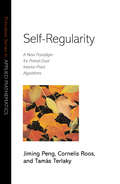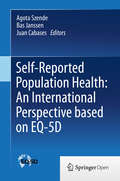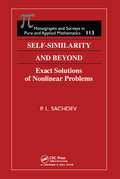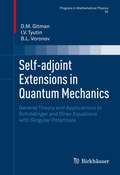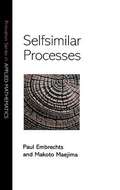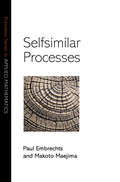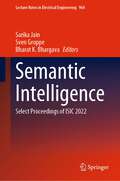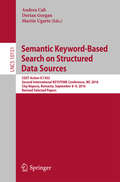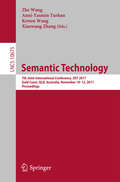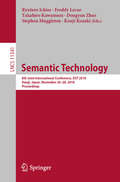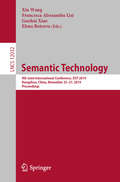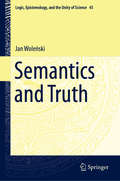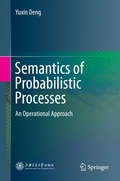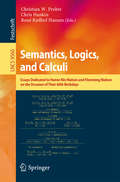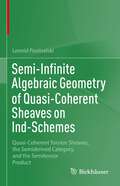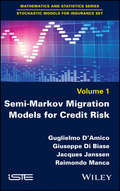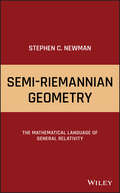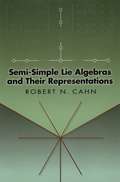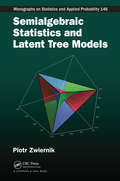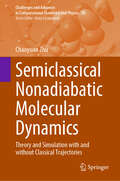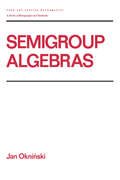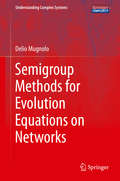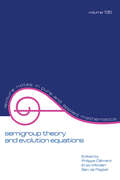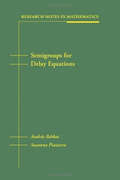- Table View
- List View
Self-Regularity: A New Paradigm for Primal-Dual Interior-Point Algorithms (Princeton Series in Applied Mathematics #22)
by Tamás Terlaky Jiming Peng Cornelis RoosResearch on interior-point methods (IPMs) has dominated the field of mathematical programming for the last two decades. Two contrasting approaches in the analysis and implementation of IPMs are the so-called small-update and large-update methods, although, until now, there has been a notorious gap between the theory and practical performance of these two strategies. This book comes close to bridging that gap, presenting a new framework for the theory of primal-dual IPMs based on the notion of the self-regularity of a function. The authors deal with linear optimization, nonlinear complementarity problems, semidefinite optimization, and second-order conic optimization problems. The framework also covers large classes of linear complementarity problems and convex optimization. The algorithm considered can be interpreted as a path-following method or a potential reduction method. Starting from a primal-dual strictly feasible point, the algorithm chooses a search direction defined by some Newton-type system derived from the self-regular proximity. The iterate is then updated, with the iterates staying in a certain neighborhood of the central path until an approximate solution to the problem is found. By extensively exploring some intriguing properties of self-regular functions, the authors establish that the complexity of large-update IPMs can come arbitrarily close to the best known iteration bounds of IPMs. Researchers and postgraduate students in all areas of linear and nonlinear optimization will find this book an important and invaluable aid to their work.
Self-Reported Population Health: An International Perspective based on EQ-5D
by Agota Szende Bas Janssen Juan CabasésThe EQ-5D instrument, as a standardized, cross-culturally validated measure of self-assessed health has a hugely important role in understanding population health within and across countries. Over the past two decades a wealth of international population health survey data have been accumulated by the EuroQol Group from research conducted in many countries across four continents. One of the success factors of the EQ-5D instruments has been the easy availability of national or international sets of EQ-5D data, as well as clear explanations and guidance for users. There is an unmet need to produce a comprehensive book that captures up-to-date and expanded information of EQ-5D self-reported health and index values. EQ-5D population norms and cross-country analyses are provided from representative national surveys of 20 countries and additional regional surveys. This book will be a must for those who believe that how people report and value health is very important.
Self-Similarity and Beyond: Exact Solutions of Nonlinear Problems (Monographs and Surveys in Pure and Applied Mathematics #113)
by P.L. SachdevNonlinearity plays a major role in the understanding of most physical, chemical, biological, and engineering sciences. Nonlinear problems fascinate scientists and engineers, but often elude exact treatment. However elusive they may be, the solutions do exist-if only one perseveres in seeking them out.Self-Similarity and Beyond presents
Self-adjoint Extensions in Quantum Mechanics
by I. V. Tyutin D. M. Gitman B. L. VoronovThis exposition is devoted to a consistent treatment of quantization problems, based on appealing to some nontrivial items of functional analysis concerning the theory of linear operators in Hilbert spaces. The authors begin by considering quantization problems in general, emphasizing the nontriviality of consistent operator construction by presenting paradoxes to the naive treatment. It then builds the necessary mathematical background following it by the theory of self-adjoint extensions. By considering several problems such as the one-dimensional Calogero problem, the Aharonov-Bohm problem, the problem of delta-like potentials and relativistic Coulomb problemIt then shows how quantization problems associated with correct definition of observables can be treated consistently for comparatively simple quantum-mechanical systems. In the end, related problems in quantum field theory are briefly introduced. This well-organized text is most suitable for students and post graduates interested in deepening their understanding of mathematical problems in quantum mechanics. However, scientists in mathematical and theoretical physics and mathematicians will also find it useful.
Selfsimilar Processes
by Paul Embrechts Makoto MaejimaThe modeling of stochastic dependence is fundamental for understanding random systems evolving in time. When measured through linear correlation, many of these systems exhibit a slow correlation decay--a phenomenon often referred to as long-memory or long-range dependence. An example of this is the absolute returns of equity data in finance. Selfsimilar stochastic processes (particularly fractional Brownian motion) have long been postulated as a means to model this behavior, and the concept of selfsimilarity for a stochastic process is now proving to be extraordinarily useful. Selfsimilarity translates into the equality in distribution between the process under a linear time change and the same process properly scaled in space, a simple scaling property that yields a remarkably rich theory with far-flung applications. After a short historical overview, this book describes the current state of knowledge about selfsimilar processes and their applications. Concepts, definitions and basic properties are emphasized, giving the reader a road map of the realm of selfsimilarity that allows for further exploration. Such topics as noncentral limit theory, long-range dependence, and operator selfsimilarity are covered alongside statistical estimation, simulation, sample path properties, and stochastic differential equations driven by selfsimilar processes. Numerous references point the reader to current applications. Though the text uses the mathematical language of the theory of stochastic processes, researchers and end-users from such diverse fields as mathematics, physics, biology, telecommunications, finance, econometrics, and environmental science will find it an ideal entry point for studying the already extensive theory and applications of selfsimilarity.
Selfsimilar Processes (Princeton Series in Applied Mathematics #7)
by Paul EmbrechtsThe modeling of stochastic dependence is fundamental for understanding random systems evolving in time. When measured through linear correlation, many of these systems exhibit a slow correlation decay--a phenomenon often referred to as long-memory or long-range dependence. An example of this is the absolute returns of equity data in finance. Selfsimilar stochastic processes (particularly fractional Brownian motion) have long been postulated as a means to model this behavior, and the concept of selfsimilarity for a stochastic process is now proving to be extraordinarily useful. Selfsimilarity translates into the equality in distribution between the process under a linear time change and the same process properly scaled in space, a simple scaling property that yields a remarkably rich theory with far-flung applications. After a short historical overview, this book describes the current state of knowledge about selfsimilar processes and their applications. Concepts, definitions and basic properties are emphasized, giving the reader a road map of the realm of selfsimilarity that allows for further exploration. Such topics as noncentral limit theory, long-range dependence, and operator selfsimilarity are covered alongside statistical estimation, simulation, sample path properties, and stochastic differential equations driven by selfsimilar processes. Numerous references point the reader to current applications. Though the text uses the mathematical language of the theory of stochastic processes, researchers and end-users from such diverse fields as mathematics, physics, biology, telecommunications, finance, econometrics, and environmental science will find it an ideal entry point for studying the already extensive theory and applications of selfsimilarity.
Semantic Intelligence: Select Proceedings of ISIC 2022 (Lecture Notes in Electrical Engineering #964)
by Sven Groppe Bharat K. Bhargava Sarika JainThis book constitutes refereed proceedings of the 2nd International Semantic Intelligence Conference (ISIC 2022). This book covers a wide range of topics, including semantic web engineering, ontology-based data access, multimodal and multilingual access, machine-to-machine communications and interoperability, knowledge extraction and ontology learning from the web, computational paradigms and computational intelligence, distributed and mobile systems, and many others. This book includes novel contributions and the latest developments from researchers across industry and academia. This book serves as a valuable reference resource for academics and researchers across the globe.
Semantic Keyword-Based Search on Structured Data Sources: COST Action IC1302 Second International KEYSTONE Conference, IKC 2016, Cluj-Napoca, Romania, September 8–9, 2016, Revised Selected Papers (Lecture Notes in Computer Science #10151)
by Andrea Calì Dorian Gorgan Martín UgarteThis book constitutes the thoroughly refereed post-conference proceedings of the Second COST Action IC1302 International KEYSTONE Conference on Semantic Keyword-Based Search on Structured Data Sources, IKC 2016, held in Cluj-Napoca, Romania, in September 2016. The 15 revised full papers and 2 invited papers are reviewed and selected from 18 initial submissions and cover the areas of keyword extraction, natural language searches, graph databases, information retrieval techniques for keyword search and document retrieval.
Semantic Technology: 7th Joint International Conference, JIST 2017, Gold Coast, QLD, Australia, November 10-12, 2017, Proceedings (Lecture Notes in Computer Science #10675)
by Zhe Wang Anni-Yasmin Turhan Kewen Wang Xiaowang ZhangThis book constitutes the thoroughly refereed proceedings of the 7th Joint International Semantic Technology Conference, JIST 2017, held in Goldcoast, QLD, Australia, in November 2017. The 19 full papers and 4 short papers presented were carefully reviewed and selected from 37 submissions. They present applications of semantic technologies, theoretical results, new algorithms and tools to facilitate the adoption of semantic technologies and are organized in topical sections on ontology and data management; ontology reasoning; linked data and query; information retrieval and knowledge discovery; knowledge graphs; and applications of semantic technologies.
Semantic Technology: 8th Joint International Conference, JIST 2018, Awaji, Japan, November 26–28, 2018, Proceedings (Lecture Notes in Computer Science #11341)
by Kouji Kozaki Dongyan Zhao Freddy Lecue Ryutaro Ichise Takahiro Kawamura Stephen MuggletonThis book constitutes the thoroughly refereed proceedings of the 8th Joint International Semantic Technology Conference, JIST 2018, held in Awaji, Japan, in November 2018. The 23 full papers and 6 short papers presented were carefully reviewed and selected from 75 submissions. They present applications of semantic technologies, theoretical results, new algorithms and tools to facilitate the adoption of semantic technologies and are organized in topical sections on knowledge graphs; data management; question answering and NLP; ontology and reasoning; government open data; and semantic web for life sciences.
Semantic Technology: 9th Joint International Conference, JIST 2019, Hangzhou, China, November 25–27, 2019, Proceedings (Lecture Notes in Computer Science #12032)
by Xin Wang Francesca Alessandra Lisi Guohui Xiao Elena BotoevaThis book constitutes the thoroughly refereed proceedings of the 9th Joint International Semantic Technology Conference, JIST 2019, held in Hangzhou, China, in November 2019. The 24 full papers presented were carefully reviewed and selected from 70 submissions. They present applications of semantic technologies, theoretical results, new algorithms and tools to facilitate the adoption of semantic technologies and are organized in topical sections on knowledge graphs; data management; question answering and NLP; ontology and reasoning; government open data; and semantic web for life sciences.
Semantics and Truth (Logic, Epistemology, and the Unity of Science #45)
by Jan WoleńskiThe book provides a historical (with an outline of the history of the concept of truth from antiquity to our time) and systematic exposition of the semantic theory of truth formulated by Alfred Tarski in the 1930s. This theory became famous very soon and inspired logicians and philosophers. It has two different, but interconnected aspects: formal-logical and philosophical. The book deals with both, but it is intended mostly as a philosophical monograph. It explains Tarski’s motivation and presents discussions about his ideas (pro and contra) as well as points out various applications of the semantic theory of truth to philosophical problems (truth-criteria, realism and anti-realism, future contingents or the concept of correspondence between language and reality).
Semantics of Probabilistic Processes
by Yuxin DengThis book discusses the semantic foundations of concurrent systems with nondeterministic and probabilistic behaviour. Particular attention is given to clarifying the relationship between testing and simulation semantics and characterising bisimulations from metric, logical, and algorithmic perspectives. Besides presenting recent research outcomes in probabilistic concurrency theory, the book exemplifies the use of many mathematical techniques to solve problems in computer science, which is intended to be accessible to postgraduate students in Computer Science and Mathematics. It can also be used by researchers and practitioners either for advanced study or for technical reference.
Semantics, Logics, and Calculi
by Christian W. Probst Chris Hankin René Rydhof HansenThis Festschrift volume is published in honorof Hanne Riis Nielson and Flemming Nielson on the occasion of their 60thbirthdays in 2014 and 2015, respectively. The papers included in this volumedeal with the wide area of calculi, semantics, and analysis. The book features contributions fromcolleagues, who have worked together with Hanne and Flemming through theirscientific life and are dedicated to them and to their work. The papers werepresented at a colloquium at the Technical University of Denmark in January2016.
Semi-Infinite Algebraic Geometry of Quasi-Coherent Sheaves on Ind-Schemes: Quasi-Coherent Torsion Sheaves, the Semiderived Category, and the Semitensor Product
by Leonid PositselskiSemi-Infinite Geometry is a theory of "doubly infinite-dimensional" geometric or topological objects. In this book the author explains what should be meant by an algebraic variety of semi-infinite nature. Then he applies the framework of semiderived categories, suggested in his previous monograph titled Homological Algebra of Semimodules and Semicontramodules, (Birkhäuser, 2010), to the study of semi-infinite algebraic varieties. Quasi-coherent torsion sheaves and flat pro-quasi-coherent pro-sheaves on ind-schemes are discussed at length in this book, making it suitable for use as an introduction to the theory of quasi-coherent sheaves on ind-schemes. The main output of the homological theory developed in this monograph is the functor of semitensor product on the semiderived category of quasi-coherent torsion sheaves, endowing the semiderived category with the structure of a tensor triangulated category. The author offers two equivalent constructions of the semitensor product, as well as its particular case, the cotensor product, and shows that they enjoy good invariance properties. Several geometric examples are discussed in detail in the book, including the cotangent bundle to an infinite-dimensional projective space, the universal fibration of quadratic cones, and the important popular example of the loop group of an affine algebraic group.
Semi-Markov Migration Models for Credit Risk
by Jacques Janssen Raimondo Manca Giuseppe Di Biase Guglielmo D'AmicoCredit risk is one of the most important contemporary problems for banks and insurance companies. Indeed, for banks, more than forty percent of the equities are necessary to cover this risk. Though this problem is studied by large rating agencies with substantial economic, social and financial tools, building stochastic models is nevertheless necessary to complete this descriptive orientation.This book presents a complete presentation of such a category of models using homogeneous and non-homogeneous semi-Markov processes developed by the authors in several recent papers. This approach provides a good method of evaluating the default risk and the classical VaR indicators used for Solvency II and Basel III governance rules.This book is the first to present a complete semi-Markov treatment of credit risk while also insisting on the practical use of the models presented here, including numerical aspects, so that this book is not only useful for scientific research but also to managers working in this field for banks, insurance companies, pension funds and other financial institutions.
Semi-Riemannian Geometry: The Mathematical Language of General Relativity
by Stephen C. NewmanAn introduction to semi-Riemannian geometry as a foundation for general relativity Semi-Riemannian Geometry: The Mathematical Language of General Relativity is an accessible exposition of the mathematics underlying general relativity. The book begins with background on linear and multilinear algebra, general topology, and real analysis. This is followed by material on the classical theory of curves and surfaces, expanded to include both the Lorentz and Euclidean signatures. The remainder of the book is devoted to a discussion of smooth manifolds, smooth manifolds with boundary, smooth manifolds with a connection, semi-Riemannian manifolds, and differential operators, culminating in applications to Maxwell’s equations and the Einstein tensor. Many worked examples and detailed diagrams are provided to aid understanding. This book will appeal especially to physics students wishing to learn more differential geometry than is usually provided in texts on general relativity. STEPHEN C. NEWMAN is Professor Emeritus at the University of Alberta, Edmonton, Alberta, Canada. He is the author of Biostatistical Methods in Epidemiology and A Classical Introduction to Galois Theory, both published by Wiley.
Semi-Simple Lie Algebras and Their Representations
by Robert N. CahnDesigned to acquaint students of particle physiME already familiar with SU(2) and SU(3) with techniques applicable to all simple Lie algebras, this text is especially suited to the study of grand unification theories. Author Robert N. Cahn, who is affiliated with the Lawrence Berkeley National Laboratory in Berkeley, California, has provided a new preface for this edition. Subjects include the killing form, the structure of simple Lie algebras and their representations, simple roots and the Cartan matrix, the classical Lie algebras, and the exceptional Lie algebras. Additional topiME include Casimir operators and Freudenthal's formula, the Weyl group, Weyl's dimension formula, reducing product representations, subalgebras, and branching rules. 1984 edition.
Semialgebraic Statistics and Latent Tree Models
by Piotr ZwiernikThe first part of the book gives a general introduction to key concepts in algebraic statistics, focusing on methods that are helpful in the study of models with hidden variables. The author uses tensor geometry as a natural language to deal with multivariate probability distributions, develops new combinatorial tools to study models with hidden data, and describes the semialgebraic structure of statistical models.The second part illustrates important examples of tree models with hidden variables. The book discusses the underlying models and related combinatorial concepts of phylogenetic trees as well as the local and global geometry of latent tree models. It also extends previous results to Gaussian latent tree models.This book shows you how both combinatorics and algebraic geometry enable a better understanding of latent tree models. It contains many results on the geometry of the models, including a detailed analysis of identifiability and the defining polynomial constraints
Semiclassical Nonadiabatic Molecular Dynamics: Theory and Simulation with and without Classical Trajectories (Challenges and Advances in Computational Chemistry and Physics #38)
by Chaoyuan ZhuThis book shows how to derive the simple and accurate semiclassical methods analytically and its applications to excited-state molecular dynamics and spectroscopy simulation with and without classical trajectories. It consists of eight chapters demonstrating interesting conical and intersystem-driven photochemical processes in complex systems targeting on large-scale ab initio direct nonadiabatic molecular dynamics. It also includes two chapters dealing with time-independent and time-dependent nonadiabatic molecular dynamics and clarifies the underline principle of Born–Oppenheimer approximation associated with coherence/decoherence quantum effects that have a wide range of applications in photochemistry and photophysics. This book is interesting and useful to a wide readership in the various fields of basic quantum chemistry and physics associated with large-scale excited-state simulation of nonadiabatic molecular dynamics and spectroscopy.
Semiclassical and Stochastic Gravity: Quantum Field Effects on Curved Spacetime (Cambridge Monographs on Mathematical Physics)
by Bei-Lok B. Hu Enric VerdaguerThe two pillars of modern physics are general relativity and quantum field theory, the former describes the large scale structure and dynamics of space-time, the latter, the microscopic constituents of matter. Combining the two yields quantum field theory in curved space-time, which is needed to understand quantum field processes in the early universe and black holes, such as the well-known Hawking effect. This book examines the effects of quantum field processes back-reacting on the background space-time which become important near the Planck time (10-43 sec). It explores the self-consistent description of both space-time and matter via the semiclassical Einstein equation of semiclassical gravity theory, exemplified by the inflationary cosmology, and fluctuations of quantum fields which underpin stochastic gravity, necessary for the description of metric fluctuations (space-time foams). Covering over four decades of thematic development, this book is a valuable resource for researchers interested in quantum field theory, gravitation and cosmology.
Semigroup Algebras
by Jan OkninskiGathers and unifies the results of the theory of noncommutative semigroup rings, primarily drawing on the literature of the last 10 years, and including several new results. Okninski (Warsaw U., Poland) restricts coverage to the ring theoretical properties for which a systematic treatment is current
Semigroup Methods for Evolution Equations on Networks
by Delio MugnoloThis concise text is based on a series of lectures held only a few years ago and originally intended as an introduction to known results on linear hyperbolic and parabolic equations. Yet the topic of differential equations on graphs, ramified spaces, and more general network-like objects has recently gained significant momentum and, well beyond the confines of mathematics, there is a lively interdisciplinary discourse on all aspects of so-called complex networks. Such network-like structures can be found in virtually all branches of science, engineering and the humanities, and future research thus calls for solid theoretical foundations. This book is specifically devoted to the study of evolution equations - i. e. , of time-dependent differential equations such as the heat equation, the wave equation, or the Schrödinger equation (quantum graphs) - bearing in mind that the majority of the literature in the last ten years on the subject of differential equations of graphs has been devoted to elliptic equations and related spectral problems. Moreover, for tackling the most general settings - e. g. encoded in the transmission conditions in the network nodes - one classical and elegant tool is that of operator semigroups. This book is simultaneously a very concise introduction to this theory and a handbook on its applications to differential equations on networks. With a more interdisciplinary readership in mind, full proofs of mathematical statements have been frequently omitted in favor of keeping the text as concise, fluid and self-contained as possible. In addition, a brief chapter devoted to the field of neurodynamics of the brain cortex provides a concrete link to ongoing applied research.
Semigroup Theory and Evolution Equations: The Second International Conference
by Ben De Pagter Philippe Clément Enzo MitidieniProceedings of the Second International Conference on Trends in Semigroup Theory and Evolution Equations held Sept. 1989, Delft University of Technology, the Netherlands. Papers deal with recent developments in semigroup theory (e.g., positive, dual, integrated), and nonlinear evolution equations (e
Semigroups for Delay Equations
by Andras Batkai Susanna PiazzeraIn most physical, chemical, biological and economic phenomena it is quite natural to assume that the system not only depends on the present state but also on past occurrences. These circumstances are mathematically described by partial differential equations with delay. This book presents, in a systematic fashion, how delay equations can be studied
